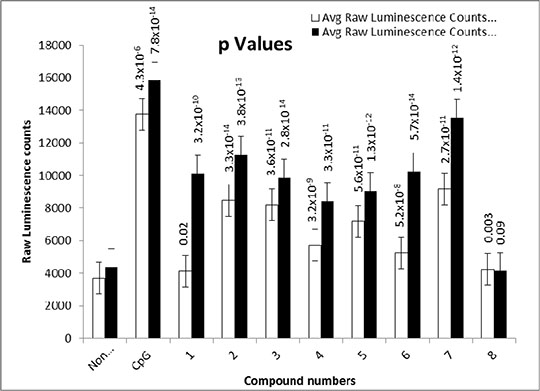Reducing The Risks Of Immunostimulation: Determination Of The Activity Of Therapeutic Oligonucleotides Against Toll-Like Receptor 9 (TLR9) Therapeutic anti-sense oligonucleotides (ASOs) are an attractive route of disease intervention, with the potential to reduce expression of specific genes at any point in a signalling cascade[1]. However, they may also activate the innate immune system, which is likely to result in undesired side effects. The innate immune system recognises both bacterial and viral pathogens through the interaction of nucleotides with pattern-recognition receptors such as Toll-Like Receptor 9 (TLR9). TLR9 differentiates self and foreign nucleotides in part through recognition of unmethylated CpG sequences, since mammalian DNA contains methylated CpG sequences[2]. Dysregulation of the immune response through inappropriate activation of TLRs can activate auto-inflammatory conditions. We developed an in vitro test to measure the potential of therapeutic ASOs to cause inappropriate immune activation via induction of TLR9. HEK293 cells were stably transfected with human TLR9 and an NFkB-Luciferase reporter gene introduced by baculovirus-mediated transduction. These cells were batch-frozen, thawed on day of test and plated in 96 well plates at a density of 2x105cells/ml.CpG2006 was used at a concentration of 1µM as a positive control and sterile water was used as a negative control. A 1 in 4 serial dilution of CpG2006 ODN in sterile water was prepared to produce 10 point Dose Response Curves with the top concentration being 10µM. The ASOs were serially diluted 1 in 3 to generate 10 point Dose Response curves. Treatment of these cells in culture with synthetic unmethylated CpG for 24 hours resulted in concentration-dependent induction of NFkB-Luciferase, which was detected using SteadyGloTM (Promega) reagent in a ViewluxTM (Perkin Elmer) luminescence plate-reader. Seven ASOs targeting the same mRNA were tested under similar conditions and none caused induction of NFkB-Luciferase while the standard compound CpG ODN 2006 was active with an average pEC50 value of 6.9. TLR9 is found mainly in the membrane of the endosomal compartment and very little is exposed on the cell membrane. We were concerned that the lack of activity of the seven ASOs might reflect their inability to penetrate the endosomal compartment in this assay. We performed a similar test to above but in the presence of a lipid agent, lipofectamine, which is known to facilitate entry of nucleotides into cells. The control unmethylated CpG had similar potency in inducing NFkB-Luciferase in the presence of 1.25μg/ml lipofectamine. However, the seven ASOs did exhibit induction of NFkB-Luciferase with lipofectamine as shown in the figure below. A Two-Sample Assuming Equal Variances t test was carried out to show the difference in activities compared to the negative control, which was a non-targetting DNA.

Different relative levels of activity allowed prioritisation for progression of these ASOs further in the drug discovery cascade. Using this general approach, potential ASOs likely to cause unwanted immunostimulatory effects were identified and will be tested further to ascertain whether the effects will be translated in in vivo rodent models. 1. Southwell, A.L., et al., Trends in Molecular Medicine, 2012. 18: 634-643. 2. Hemmi, H., et al., Nature, 2000. 408: 740-745.
|


